It looks like you're using an Ad Blocker.
Please white-list or disable AboveTopSecret.com in your ad-blocking tool.
Thank you.
Some features of ATS will be disabled while you continue to use an ad-blocker.
share:
***ATTENTION***
The topic of this thread is Hubble: Why It Can See Galaxies But Not That Moon Rock.
NOT anything else. Post on topic, or do not post at all. Further off-topic remarks will be removed.
Repeat offenders will be post banned. Do not reply to this post.
~Tenth
ATS Super Mod
The topic of this thread is Hubble: Why It Can See Galaxies But Not That Moon Rock.
NOT anything else. Post on topic, or do not post at all. Further off-topic remarks will be removed.
Repeat offenders will be post banned. Do not reply to this post.
~Tenth
ATS Super Mod
(post by tanka418 removed for a manners violation)
a reply to: tanka418
YET AGAIN for the hard of learning the thread title !
Hubble: Why It Can See Galaxies But Not That Moon Rock
The important words in BOLD!
I started a thread about what the night sky would look like if the Andromeda galaxy was brighter.
Here are a couple of posts from that thread.
The picture I linked to first
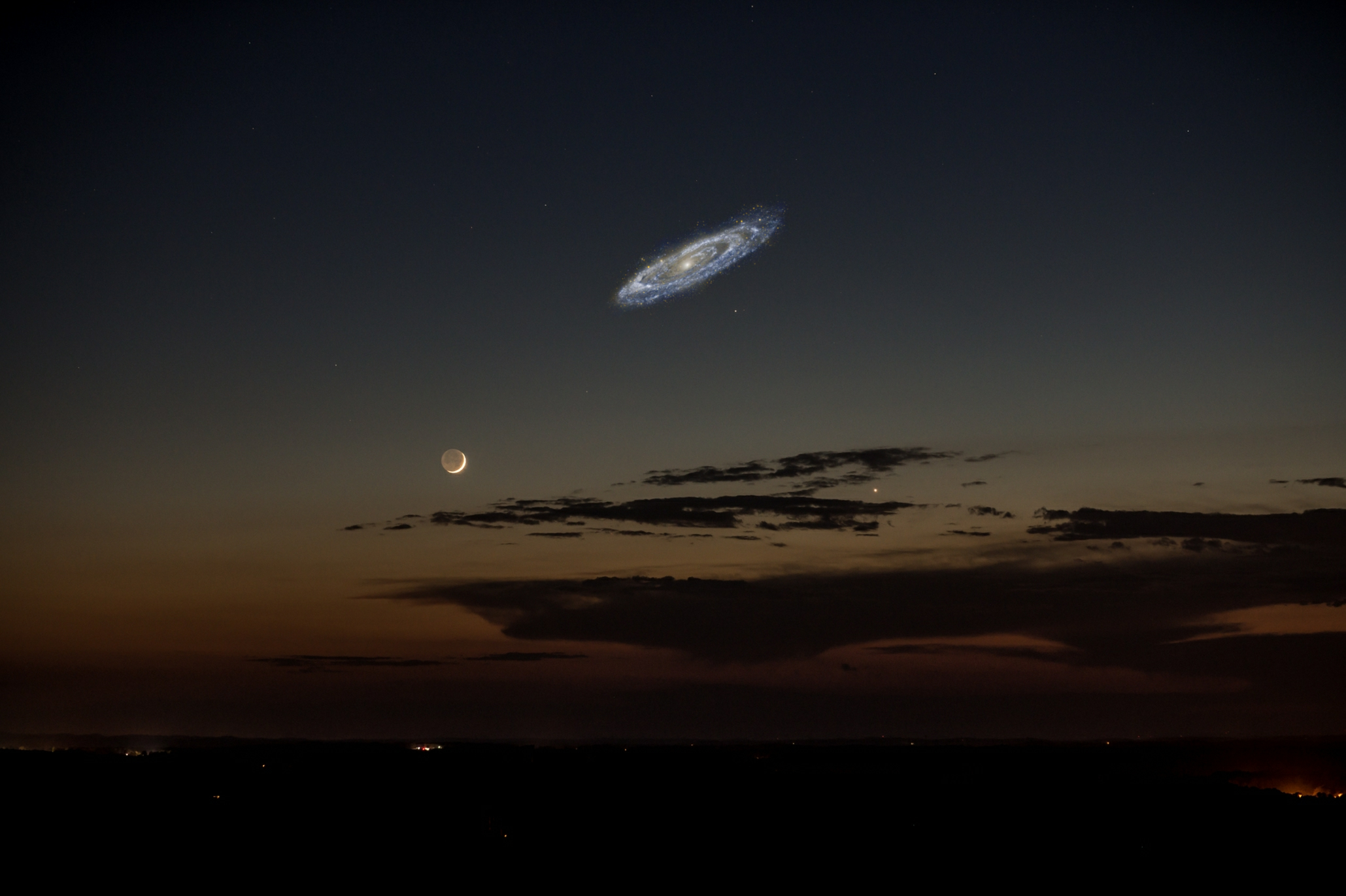
Some of the posts
That's just a few examples to show that people who are not keen astronomers/astrophotographers think that Galaxies are always small in a image and if it can show them it should be able to see great detail on the Moon possibly even the landers, that question comes up MANY times on Moon hoax threads on here.
That's why erik did the thread to explain why it can't show the landers, small rocks or craters etc?
Now has it sunk in yet
YET AGAIN for the hard of learning the thread title !
Hubble: Why It Can See Galaxies But Not That Moon Rock
The important words in BOLD!
I started a thread about what the night sky would look like if the Andromeda galaxy was brighter.
Here are a couple of posts from that thread.
The picture I linked to first

Some of the posts
originally posted by: Aleister
Seriously, it's that large in reality? I never knew that, I just thought it was that small area of the sky. Really? Mind blown, or at least a portion of it taken past a preconceived reality-tunnel structure. Thanks!
originally posted by: jeep3r
Excellent comparison which I wasn't aware of ..
originally posted by: Nyiah
Holy smokes, OP, that's gorgeous! I knew it was supposed to be on the large side if our eyes could see it, but I'm taken aback a little. I've never realized just how large it would be. Talk about perspective
That's just a few examples to show that people who are not keen astronomers/astrophotographers think that Galaxies are always small in a image and if it can show them it should be able to see great detail on the Moon possibly even the landers, that question comes up MANY times on Moon hoax threads on here.
That's why erik did the thread to explain why it can't show the landers, small rocks or craters etc?
Now has it sunk in yet
Ok
Im stopping the Merry Go Round Here
Here is a Lecture from Richard A. Muller
saying the exact same thing im trying to explain here
what started this endless debate .. of what we are actually seeing when we are looking at a Different Galaxy
and about those stars in the foreground in pictures of galaxy's are they from OUR Galaxy or from There's
'the focus is the Andromeda Galaxy '
We can see stars up and close at the Edge of OUR Galaxy's
As Muller has said about closer big and bright and farther Smaller Dim...
Just See the first 5 Minutes of this Physics Lecture Video
www.youtube.com...
y
NOTE: you have to Move the the button all the way to the begining
Im stopping the Merry Go Round Here
Here is a Lecture from Richard A. Muller
saying the exact same thing im trying to explain here
what started this endless debate .. of what we are actually seeing when we are looking at a Different Galaxy
and about those stars in the foreground in pictures of galaxy's are they from OUR Galaxy or from There's
'the focus is the Andromeda Galaxy '
We can see stars up and close at the Edge of OUR Galaxy's
As Muller has said about closer big and bright and farther Smaller Dim...
Just See the first 5 Minutes of this Physics Lecture Video
www.youtube.com...
y
NOTE: you have to Move the the button all the way to the begining
edit on 12015MondayfAmerica/Chicago6179 by Wolfenz because: (no reason given)
edit on 12015MondayfAmerica/Chicago6179 by
Wolfenz because: (no reason given)
edit on 12015MondayfAmerica/Chicago6179 by Wolfenz because: (no reason given)
a reply to: Wolfenz
Yes -- he says that the stars that are closer to appear to be brighter and the farther stars appear to be dimmer. However it is still the case that when you see the big bright blob of a star that you see in this image, your are NOT looking at a star so close up that you can see its dimensions (i.e., the perimeter of the blob is NOT the surface of the star).
The reason for the big blob of star is not because it is close enough to see the actual size of the star, but rather it is so close and/or bight that its overexposed glare makes it only seem as if we could see the actual size of it with the telescope.
The telescope can still only resolve these stars as points of light. The bright ones may make us THINK we can see the diameter of the star, but it is just glare and overexposure.
Yes -- he says that the stars that are closer to appear to be brighter and the farther stars appear to be dimmer. However it is still the case that when you see the big bright blob of a star that you see in this image, your are NOT looking at a star so close up that you can see its dimensions (i.e., the perimeter of the blob is NOT the surface of the star).
The reason for the big blob of star is not because it is close enough to see the actual size of the star, but rather it is so close and/or bight that its overexposed glare makes it only seem as if we could see the actual size of it with the telescope.
The telescope can still only resolve these stars as points of light. The bright ones may make us THINK we can see the diameter of the star, but it is just glare and overexposure.
edit on 6/29/2015 by Soylent Green Is People because: (no reason given)
originally posted by: Soylent Green Is People
a reply to: Wolfenz
Yes -- he says that the stars that are closer to appear to be brighter and the farther stars appear to be dimmer. However it is still the case that when you see the big bright blob of a star that you see in this image, your are NOT looking at a star so close up that you can see its dimensions (i.e., the perimeter of the blob is NOT the surface of the star).
The reason for the big blob of star is not because it is close enough to see the actual size of the star, but rather it is so close and/or bight that its overexposed glare makes it only seem as if we could see the actual size of it with the telescope.
as you said:
The reason for the big blob of star is not because it is close enough to see the actual size of the star, but rather it is so close and/or bight that its overexposed glare
The telescope can still only resolve these stars as points of light. The bright ones may make us THINK we can see the diameter of the star, but it is just glare and overexposure.
Right I Agree with you the Over exposure .. a Flair up.. not the actual dimension.. I understand this ..
but will there be a way to Overcome this with certain filters .. in Time?
like the X-ray Scope that can see the Core (Center ) of Andromeda of what it contains like a Black hole ..
other then the HubbleScope an actual visual scope ..
and I mention of Spy Satellites
KH - 11
image.slidesharecdn.com...
Resolution comparison
landtrustgis.org...
2 different Spy Satellites showing the comparison Corona & Spot
www.nuclearweaponarchive.org...
as we need a Newer Hubble Scope since tit been there since the early 1990s
Unfortunately this is all we can see with Hubble
when the Hubble-scope is looking directly Onto ONE Star
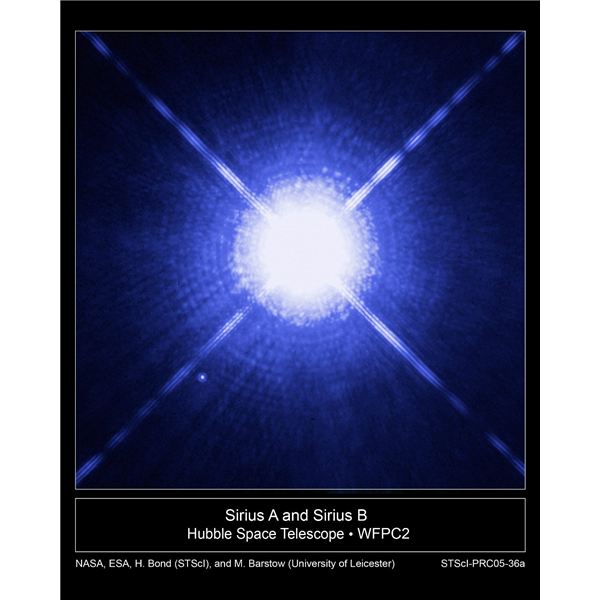
edit on 12015MondayfAmerica/Chicago6179 by Wolfenz because: (no reason given)
a reply to: Wolfenz
The two objects in the images of the Andromeda Galaxy that you are insisting are stars, are actually satellite dwarf galaxies orbiting the Andromeda Galaxy itself.
The more disc like one is known as M110. It's almost 2.7 million lightyears away. In 1999 a nova appeared in it.
The more circular one is known as M32. It actually contains a massive black hole at it's center like our own galaxy and the Andromeda Galaxy itself.
There are several reasons why neither of these objects can be stars that are located within our own galaxy:
1) As explained in my OP of this thread, even a star that is very close to us, like Alpha Centauri A that is bigger than our sun at about 1 million miles across, and is only 4.3 lightyears away, is still so far away, that no details can be made of it's surface. It's only a point of light. If you look at it with a telescope, that is all you'll see with your eyes: a bright point of light. If you use a camera, and take exposures of it, the longer you expose the frame, the brighter it will get, and the more sensors of the CCD chip will be come saturated.
Many of us on here that you are talking to also do astrophotography, and have posted many of our pictures in a thread right here on ATS. You can see this in our images we have posted.
Taking images of galaxies requires long exposure times. This in turn will make the small points of light of the stars to appear even bigger, because their light is easier to capture in an image.
If you have a CCD camera that you can manually set the exposure time, you can test this for yourself using a known object size, like say the full moon. Using a tripod, take pictures of the moon. Make your exposures longer and longer, and watch what happens.
Or you can just look at the pictures I took of the Moon below. With each frame, I've increased the exposure time, and with each frame, you can see that the light makes the Moon look bigger and bigger:

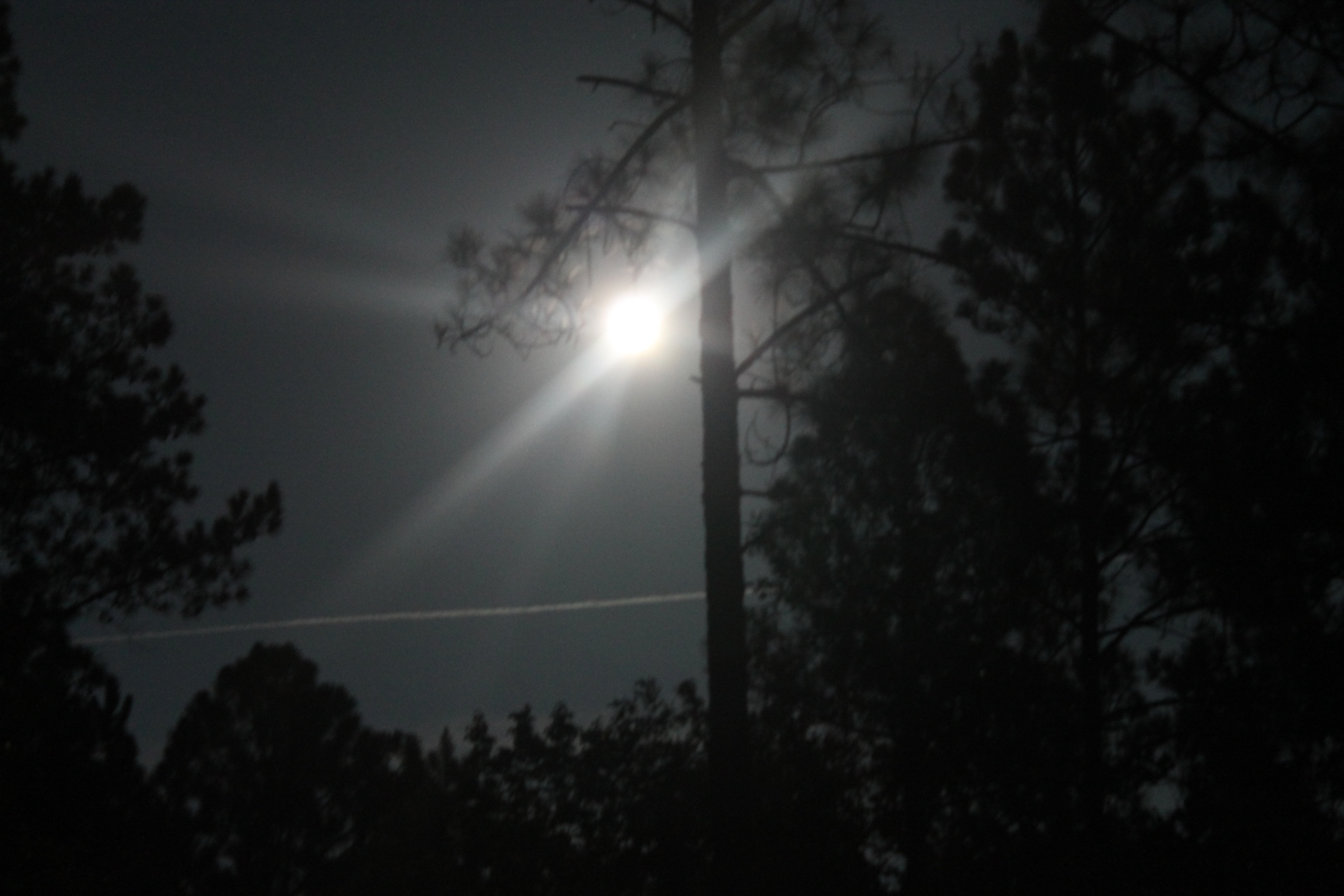

2) Parallax. Due to the fact that stars have a upper limit of what size they can be (and that size is pretty damn big, but there is a limit), in order for M32 and M110 to be stars who's shape we could see, they would need to be close. Very close to us. Well within the 1,600 light year limit that using Parallax affords us the ability to tell what the distance a object is from us. Both M32 and M110 can not be measure with Parallax. Why? Because they are much too far away to measure with that method.
If they are that far away, and due to the limit of how big a star can be, then they must not be stars.
3) Stellar Motion: All the stars in our galaxy are orbiting around the center of our galaxy, including our sun. Due to the fact that we have records going back even thousands of years (you can thank the Chinese for that), we have very good records recording the positions of stars in the sky. Over time, the stars move. Even in a 50 to 100 year time period, the motion of stars within our galaxy is quite measurable.
Neither M32 or M110 have moved with enough motion to show that they lay within our galaxy. Instead, their motions show that they are:
A) Very far away indeed and,
B) Are in orbit around another body: The Andromeda Galaxy.
That leaves only one conclusion - Their apparent size is big, they are very far away, and they seem to orbit another galaxy, making them dwarf galaxies.
Not stars.
So no, I'm afraid you have not "stopped any merry go round".
You do not have to take any of our words seriously if you don't want to. Instead, located different professional astronomers that you can email and ask any one of them if you don't believe us.
The two objects in the images of the Andromeda Galaxy that you are insisting are stars, are actually satellite dwarf galaxies orbiting the Andromeda Galaxy itself.
The more disc like one is known as M110. It's almost 2.7 million lightyears away. In 1999 a nova appeared in it.
The more circular one is known as M32. It actually contains a massive black hole at it's center like our own galaxy and the Andromeda Galaxy itself.
There are several reasons why neither of these objects can be stars that are located within our own galaxy:
1) As explained in my OP of this thread, even a star that is very close to us, like Alpha Centauri A that is bigger than our sun at about 1 million miles across, and is only 4.3 lightyears away, is still so far away, that no details can be made of it's surface. It's only a point of light. If you look at it with a telescope, that is all you'll see with your eyes: a bright point of light. If you use a camera, and take exposures of it, the longer you expose the frame, the brighter it will get, and the more sensors of the CCD chip will be come saturated.
Many of us on here that you are talking to also do astrophotography, and have posted many of our pictures in a thread right here on ATS. You can see this in our images we have posted.
Taking images of galaxies requires long exposure times. This in turn will make the small points of light of the stars to appear even bigger, because their light is easier to capture in an image.
If you have a CCD camera that you can manually set the exposure time, you can test this for yourself using a known object size, like say the full moon. Using a tripod, take pictures of the moon. Make your exposures longer and longer, and watch what happens.
Or you can just look at the pictures I took of the Moon below. With each frame, I've increased the exposure time, and with each frame, you can see that the light makes the Moon look bigger and bigger:



2) Parallax. Due to the fact that stars have a upper limit of what size they can be (and that size is pretty damn big, but there is a limit), in order for M32 and M110 to be stars who's shape we could see, they would need to be close. Very close to us. Well within the 1,600 light year limit that using Parallax affords us the ability to tell what the distance a object is from us. Both M32 and M110 can not be measure with Parallax. Why? Because they are much too far away to measure with that method.
If they are that far away, and due to the limit of how big a star can be, then they must not be stars.
3) Stellar Motion: All the stars in our galaxy are orbiting around the center of our galaxy, including our sun. Due to the fact that we have records going back even thousands of years (you can thank the Chinese for that), we have very good records recording the positions of stars in the sky. Over time, the stars move. Even in a 50 to 100 year time period, the motion of stars within our galaxy is quite measurable.
Neither M32 or M110 have moved with enough motion to show that they lay within our galaxy. Instead, their motions show that they are:
A) Very far away indeed and,
B) Are in orbit around another body: The Andromeda Galaxy.
That leaves only one conclusion - Their apparent size is big, they are very far away, and they seem to orbit another galaxy, making them dwarf galaxies.
Not stars.
So no, I'm afraid you have not "stopped any merry go round".
You do not have to take any of our words seriously if you don't want to. Instead, located different professional astronomers that you can email and ask any one of them if you don't believe us.
originally posted by: eriktheawful
a reply to: Wolfenz
The two objects in the images of the Andromeda Galaxy that you are insisting are stars, are actually satellite dwarf galaxies orbiting the Andromeda Galaxy itself.
The more disc like one is known as M110. It's almost 2.7 million lightyears away. In 1999 a nova appeared in it.
The more circular one is known as M32. It actually contains a massive black hole at it's center like our own galaxy and the Andromeda Galaxy itself.
( Wolfenz ) yes I knew about the Black Hole I mentioned that and posted a Link too that ...
There are several reasons why neither of these objects can be stars that are located within our own galaxy:
1) As explained in my OP of this thread, even a star that is very close to us, like Alpha Centauri A that is bigger than our sun at about 1 million miles across, and is only 4.3 lightyears away, is still so far away, that no details can be made of it's surface. It's only a point of light. If you look at it with a telescope, that is all you'll see with your eyes: a bright point of light. If you use a camera, and take exposures of it, the longer you expose the frame, the brighter it will get, and the more sensors of the CCD chip will be come saturated.
Many of us on here that you are talking to also do astrophotography, and have posted many of our pictures in a thread right here on ATS. You can see this in our images we have posted.
Taking images of galaxies requires long exposure times. This in turn will make the small points of light of the stars to appear even bigger, because their light is easier to capture in an image.
If you have a CCD camera that you can manually set the exposure time, you can test this for yourself using a known object size, like say the full moon. Using a tripod, take pictures of the moon. Make your exposures longer and longer, and watch what happens.
Or you can just look at the pictures I took of the Moon below. With each frame, I've increased the exposure time, and with each frame, you can see that the light makes the Moon look bigger and bigger:
2) Parallax. Due to the fact that stars have a upper limit of what size they can be (and that size is pretty damn big, but there is a limit), in order for M32 and M110 to be stars who's shape we could see, they would need to be close. Very close to us. Well within the 1,600 light year limit that using Parallax affords us the ability to tell what the distance a object is from us. Both M32 and M110 can not be measure with Parallax. Why? Because they are much too far away to measure with that method.
If they are that far away, and due to the limit of how big a star can be, then they must not be stars.
3) Stellar Motion: All the stars in our galaxy are orbiting around the center of our galaxy, including our sun. Due to the fact that we have records going back even thousands of years (you can thank the Chinese for that), we have very good records recording the positions of stars in the sky. Over time, the stars move. Even in a 50 to 100 year time period, the motion of stars within our galaxy is quite measurable.
Neither M32 or M110 have moved with enough motion to show that they lay within our galaxy. Instead, their motions show that they are:
A) Very far away indeed and,
B) Are in orbit around another body: The Andromeda Galaxy.
That leaves only one conclusion - Their apparent size is big, they are very far away, and they seem to orbit another galaxy, making them dwarf galaxies.
Not stars.
So no, I'm afraid you have not "stopped any merry go round".
You do not have to take any of our words seriously if you don't want to. Instead, located different professional astronomers that you can email and ask any one of them if you don't believe us.
The two objects in the images of the Andromeda Galaxy that you are insisting are stars, are actually satellite dwarf galaxies orbiting the Andromeda Galaxy itself.
NOPE WRONG ! I Pointed that Out and yes I know of the M32 and M110 and wasnt including them ! I mention this! it what is near them..
I placed a Boxed in the Stars, of those 2 in question, thats, if you have Looked ... )
See: Physics 10 - Lecture 25: Universe II on youtube the First 5 minutes
Link: www.youtube.com...
Then Ask yourself that Question again.. )))))
Well... then just maybe I should Link this Thread to Richard A Muller through E mail and Take it up to him ..
about where some stars in the foreground of photos of Galaxy's are are from Our Milky way or from the Galaxy its self .. as Richard A Muller Believes that those stars in the foreground are from the Milky way .. caught in View of Andromeda .. as I said the Stars are Bombing the Photo more Less
a Wiki Brief Profile of:
Richard A. Muller
en.wikipedia.org...
before Jumping the Gun Read the latest Posts .. Thanks ...
ohh yeah that pic ( Andromeda Galaxy ) of those 2 Stars from the Milkyway are the ones, Boxed in there are others, i just did not box them in
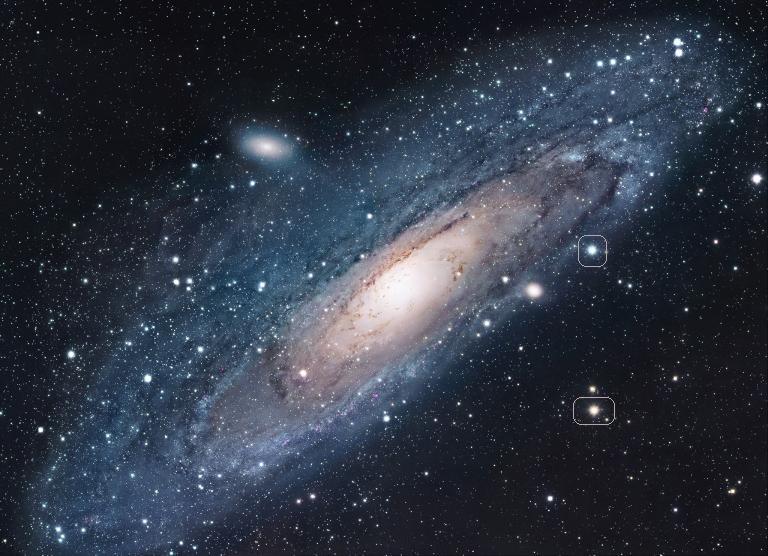
thanks for the overexposeure pics, that what im talking about of some kind of filter on the hubble to see those stars more clearly
well if we can see the sun in a clear picture whne filtered why cant we do the same with hubble or some other visual scope as to place a filter onto it
edit on 12015MondayfAmerica/Chicago6179 by Wolfenz because: (no reason given)
Well how about this ... a better explaining !
Faulkes Telescope Project
Using Filters
www.faulkes-telescope.com...
Notice from the filter Especailty the H-Alpha Filter
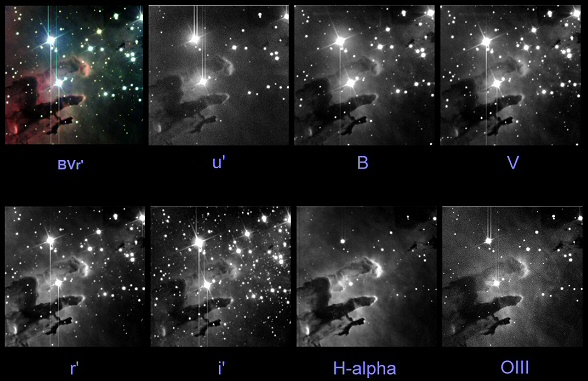

or this method
Signal Processing: Continuous and Discrete
ocw.mit.edu...
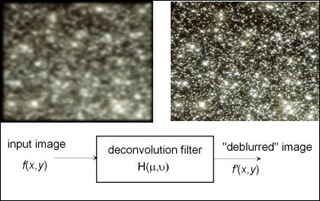
Data from instruments can be analyzed using filters to enhance different features; here, a deconvolution filter extracts a more detailed image from a blurry photo taken by the Hubble telescope. (Image by Prof. Derek Rowe
Faulkes Telescope Project
Using Filters
www.faulkes-telescope.com...
Notice from the filter Especailty the H-Alpha Filter


or this method
Signal Processing: Continuous and Discrete
ocw.mit.edu...

Data from instruments can be analyzed using filters to enhance different features; here, a deconvolution filter extracts a more detailed image from a blurry photo taken by the Hubble telescope. (Image by Prof. Derek Rowe
a reply to: Wolfenz
The filter allows you to see a restricted wavelength your deconvolved shots still only show stars as dots!
The old picture of Andromeda you used first had NO boxes one of the objects was M32 the other a star the other star you have put a box round was not clear on the image.
Using you newer image with the boxes and stellarium software the star nearest M32 is 163 light years away from us the one lower down is 1672 light years away.
The angular size of Sirius the brightest star in the sky and the cause of so MANY ufo reports on here is
0.007″ compare that to Hubble's angular resolution 0.05
It's only 8.6 light years away and at least twice the diameter of the Sun.
Looking at the figures above now can you understand why you wont see details on a star with Hubble.
Filters won't HELP is that now a bit clearer for you
The filter allows you to see a restricted wavelength your deconvolved shots still only show stars as dots!
The old picture of Andromeda you used first had NO boxes one of the objects was M32 the other a star the other star you have put a box round was not clear on the image.
Using you newer image with the boxes and stellarium software the star nearest M32 is 163 light years away from us the one lower down is 1672 light years away.
The angular size of Sirius the brightest star in the sky and the cause of so MANY ufo reports on here is
0.007″ compare that to Hubble's angular resolution 0.05
It's only 8.6 light years away and at least twice the diameter of the Sun.
Looking at the figures above now can you understand why you wont see details on a star with Hubble.
Filters won't HELP is that now a bit clearer for you
edit on 30-6-2015 by wmd_2008 because: (no reason given)
edit on
30-6-2015 by wmd_2008 because: (no reason given)
We can design microscopes to see very small things, binoculars to watch birds, telescopes for the average consumer to spot stars and planets, larger
telescope observatories to get a little more detail of the sky, and hubble to see distant outer space. Why is there such a huge gap between
telescopes/obsvervatories, and Hubble? Why is it seemingly impossible to design another hubble-like spacebased telescope that can sharply view
objects in our own solar system?
a reply to: guessingsomething
We send probes its easier and you get better images than building a large telescope.
We send probes its easier and you get better images than building a large telescope.
a reply to: guessingsomething
As wmd_2008 said: it's actually easier / cheaper to send probes with cameras when it comes to objects within our solar system.
Resolving power for telescopes is dependent upon the size of the primary reflector basically. We'd have to make telescopes much bigger than anything we've built before (or are planing to build in the near future), and it costs a LOT of money to do so.
I would be very happy to see a 10 kilometer wide space based telescope. But I certainly do not have the many billions of dollars to develop, build and put it in space.
As wmd_2008 said: it's actually easier / cheaper to send probes with cameras when it comes to objects within our solar system.
Resolving power for telescopes is dependent upon the size of the primary reflector basically. We'd have to make telescopes much bigger than anything we've built before (or are planing to build in the near future), and it costs a LOT of money to do so.
I would be very happy to see a 10 kilometer wide space based telescope. But I certainly do not have the many billions of dollars to develop, build and put it in space.
a reply to: Wolfenz
Filters usually involve blocking different wavelengths of light, by either blocking all but one wavelength, or blocking a single wavelength.
They do not change the aperture size of your telescope.
Filters are applied to the eye pieces or camera. They are not normally applied to the opening of the telescope, and with good reason: cost. Can you imagine the cost of a single H-alpha filter that would be 10 meters wide? Or having to change that filter?
Angular resolution for a telescope is determined based upon the wavelength of light that enters the telescope:

Where "R" is radians, "D" is the diameter of the telescope, and the lamda symbol is the wavelength of light. This is what Dawes Limit is based upon, using a wave length of 562 nm. Visible light is 390 nm to 700 nm. Changing that wavelength will change the answer, but not by a whole lot and certainly not enough to make a telescope see better surface details from an object that is too small and much too far away.
In any case, again, the filter is being applied to the eyepiece or camera.
The eye piece itself magnifies the light.....but at a cost. The more you magnify the light (the more powerful the eye piece) the dimmer the view. Couple that with a filter that blocks certain wavelengths of light or only allows certain wavelengths of light.
Sorry, but you can't argue the math of it. I mean you could if you want to, but it doesn't change how telescopes work and how their resolving power works.
Hubble's resolving power is 0.05 arcseconds. At 4.3 lightyears, 0.05 arcseconds is 7 million miles wide. Alpha Centauri A is only about 1 million miles wide. It's just too small for Hubble to see nothing more than a point of light.
There are much bigger stars. Say like Rigel in the constellation Orion. It's a very large star at 33.5 million miles wide. But, it's also 772 lightyears away. So while it's a LOT bigger than Alpha Centauri A, it's a LOT further away too. So far away that 0.05 arcseconds at that distance is much bigger than 33.5 million miles, so again, Hubble can't resolve Rigel's surface. It can only see a point of light.
Just like the light on top of a radio tower. If you were within 10 feet of it, you most likely could make out surface details of the light. But if you're standing half a mile away, all your eyes will see is a point of light. You could try looking at that light through different filters, but it won't change the fact that the resolving power of your eyeball is 60 arcseconds, and it won't change the fact that the lightbulb is too small, and too far away for your eyes to make out any of it's surface details, no mater what type of filter you use.
Filters usually involve blocking different wavelengths of light, by either blocking all but one wavelength, or blocking a single wavelength.
They do not change the aperture size of your telescope.
Filters are applied to the eye pieces or camera. They are not normally applied to the opening of the telescope, and with good reason: cost. Can you imagine the cost of a single H-alpha filter that would be 10 meters wide? Or having to change that filter?
Angular resolution for a telescope is determined based upon the wavelength of light that enters the telescope:

Where "R" is radians, "D" is the diameter of the telescope, and the lamda symbol is the wavelength of light. This is what Dawes Limit is based upon, using a wave length of 562 nm. Visible light is 390 nm to 700 nm. Changing that wavelength will change the answer, but not by a whole lot and certainly not enough to make a telescope see better surface details from an object that is too small and much too far away.
In any case, again, the filter is being applied to the eyepiece or camera.
The eye piece itself magnifies the light.....but at a cost. The more you magnify the light (the more powerful the eye piece) the dimmer the view. Couple that with a filter that blocks certain wavelengths of light or only allows certain wavelengths of light.
Sorry, but you can't argue the math of it. I mean you could if you want to, but it doesn't change how telescopes work and how their resolving power works.
Hubble's resolving power is 0.05 arcseconds. At 4.3 lightyears, 0.05 arcseconds is 7 million miles wide. Alpha Centauri A is only about 1 million miles wide. It's just too small for Hubble to see nothing more than a point of light.
There are much bigger stars. Say like Rigel in the constellation Orion. It's a very large star at 33.5 million miles wide. But, it's also 772 lightyears away. So while it's a LOT bigger than Alpha Centauri A, it's a LOT further away too. So far away that 0.05 arcseconds at that distance is much bigger than 33.5 million miles, so again, Hubble can't resolve Rigel's surface. It can only see a point of light.
Just like the light on top of a radio tower. If you were within 10 feet of it, you most likely could make out surface details of the light. But if you're standing half a mile away, all your eyes will see is a point of light. You could try looking at that light through different filters, but it won't change the fact that the resolving power of your eyeball is 60 arcseconds, and it won't change the fact that the lightbulb is too small, and too far away for your eyes to make out any of it's surface details, no mater what type of filter you use.
edit on 6/30/2015 by eriktheawful because: (no reason given)
originally posted by: guessingsomething
Why is there such a huge gap between telescopes/obsvervatories, and Hubble? Why is it seemingly impossible to design another hubble-like spacebased telescope that can sharply view objects in our own solar system?
There isn't a huge gap when it comes to power. In fact, ground-based telescopes are MORE POWERFUL than Hubble.
Even though Hubble is less powerful than ground-based telescopes, Hubble's advantage over these larger more pwerful telescopes is twofold:
First, Hubble is in space, so there is no thick atmosphere it needs to see through. The Earth's atmosphere can cause distortions that adversely affect how sharp and clear a space object can be seen when viewed through a ground based telescope. New technologies (such as computer-controlled adaptive optics) are helping to mitigate this problem, but it is still an issue that Hubble does not need to contend with.
Secondly, Hubble is out in space where it is always dark. This is important because Hubble can stare at a distant object for a very long time, allowing more of the light from that object to be gathered by Hubble. Ground based telescopes have daytime to deal with, so it cannot continuously stare at a single object for a long period of time.
An example of Hubble's long-exposure light gathering capabilities can be seen in Hubble's famous "deep field" views showing thousands of galaxies in one small patch of sky. The various "Hubble Deep Field" images were made by staring at one small region of space non-stop for 10 to 11 continuous days. This took full advantage of Hubble's light-gathering capabilities, and allowed the extreme dim light from those far away galaxies to be seen in these very-long exposure images.
SO...
Hubble's advantage is its light-gathering capabilities, not its magnification power, which is not that great compared to other larger ground-based telescopes.
edit on 6/30/2015 by Soylent Green Is People because: (no reason given)
a reply to: eriktheawful
That was incredibly informative and educational, thank you for taking the time to put this together!
That was incredibly informative and educational, thank you for taking the time to put this together!
a reply to: eriktheawful
Well We just have to Wait and see what technolagy brings us within the Next decade
Filters .. yeah expensive I agree ...
but for considering that The Hubble is around 24 years Old ...
Time to Upgrade to a Newer Visual Space Scope..
Meanwhile Erik the Awful
I find this Interesting
See most ON this Thread Are merely saying a Filter Wont Work
back in 2004 ..
From a a Telescope on the Ground ..
KECK PICTURES OF URANUS SHOW BEST VIEW FROM THE GROUND
November 10, 2004
www.keckobservatory.org...
Im going to place ONLY a Few Points here from the website Article Page .. But Please, Do read it...
and that filter is Called (AO) Adaptive Optics
Adaptive optics
en.wikipedia.org...
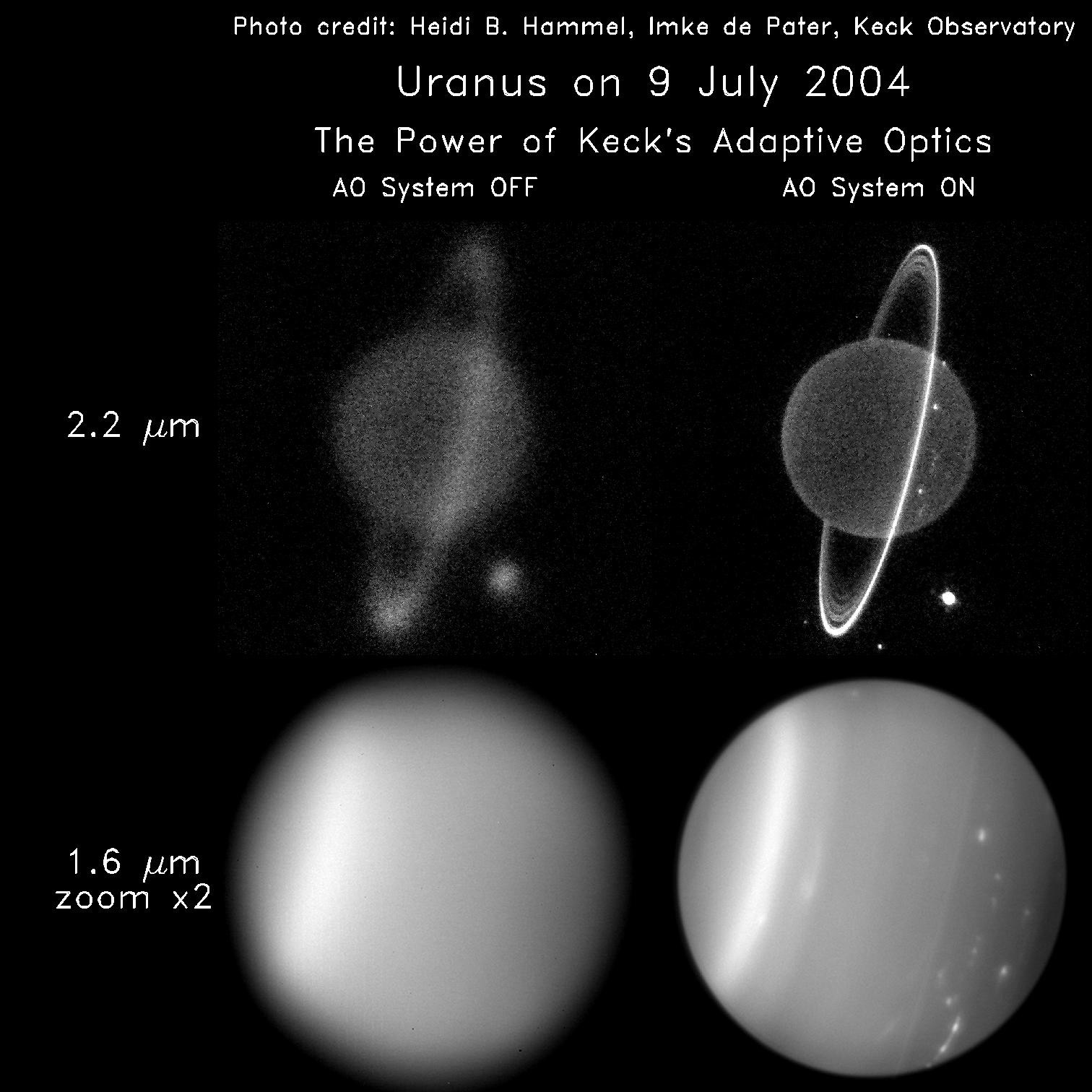
Better View
www.keckobservatory.org...
The progress of Improvement
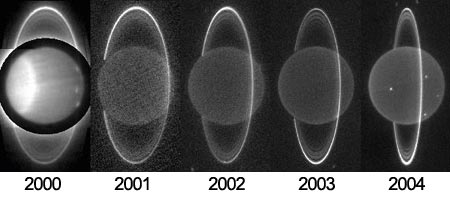
9 Years Later ...
Adaptive optics system clobbers Hubble with the sharpest-ever telescopic images
By Brian Dodson - August 28, 2013
9 Pictures
www.gizmag.com...
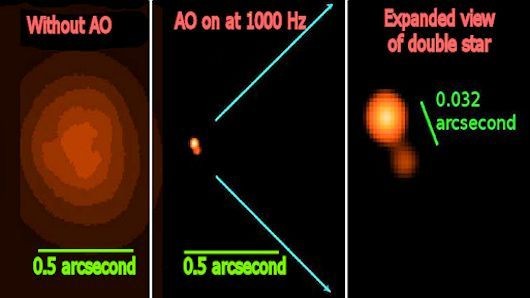
(Infrared )
In the heart of the Orion Nebula
First high-resolution image of the young high-mass binary star Theta 1 Ori C with ESO's VLT interferometer
April 02, 2009
www.mpg.de...
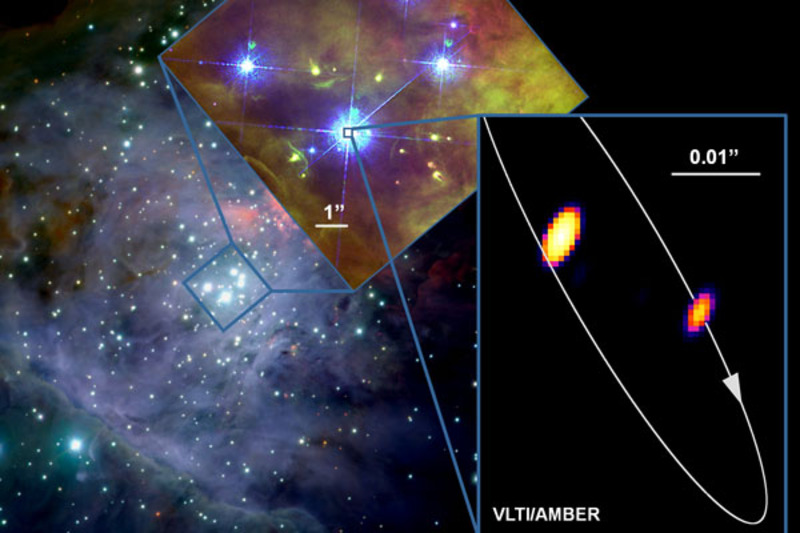
Theta 1 Ori C
Well We just have to Wait and see what technolagy brings us within the Next decade
Filters .. yeah expensive I agree ...
but for considering that The Hubble is around 24 years Old ...
Time to Upgrade to a Newer Visual Space Scope..
Meanwhile Erik the Awful
I find this Interesting
See most ON this Thread Are merely saying a Filter Wont Work
back in 2004 ..
From a a Telescope on the Ground ..
KECK PICTURES OF URANUS SHOW BEST VIEW FROM THE GROUND
November 10, 2004
www.keckobservatory.org...
Im going to place ONLY a Few Points here from the website Article Page .. But Please, Do read it...
Two separate teams of astronomers, one from Berkeley/SSI and one from Wisconsin, used advances in Keck adaptive optics (AO) to help make major scientific discoveries regarding the planet’s atmosphere and ring system. The results are a powerful example of how ground-based telescopes are helping astronomers study planets in the outer solar system that once could only be studied from space.
We are stunned by the quality and detail of these images,” said Dr. Frederic Chaffee, director of the W. M. Keck Observatory in Hawaii. “These are the best pictures of Uranus that have ever been produced by a telescope, and they are opening new windows of understanding for this unique and special world.”
The two teams used narrow filters at infrared wavelengths to study features in the atmosphere and ring sets, both of which are enormously enhanced by the Keck adaptive optics system. Ground-based telescopes are helping astronomers track climatic changes in the planet’s atmosphere.
and that filter is Called (AO) Adaptive Optics
Adaptive optics
en.wikipedia.org...

Better View
www.keckobservatory.org...
The progress of Improvement

9 Years Later ...
Adaptive optics system clobbers Hubble with the sharpest-ever telescopic images
By Brian Dodson - August 28, 2013
9 Pictures
www.gizmag.com...

Images taken by the 6.5 meter Clay telescope with and without the new adaptive optics system showing Theta 1 Ori C as a double star for the first time (Photo: Laird Close, University of Arizona)
Astronomers have developed a new visible-light adaptive optics (AO) system for the 6.5 meter diameter Magellan-Clay telescope in Chile's Atacama desert. The new AO system replaces the secondary mirror of the telescope with a thin adaptive mirror that can be deformed by its 585 mechanical actuators at a rate of more than 1000 times a second to correct for the image smearing effects of atmospheric turbulence. The result is the sharpest astronomical images ever produced – more than twice as sharp as can be achieved by the Hubble space telescope viewing objects through the vacuum of space.
(Infrared )
In the heart of the Orion Nebula
First high-resolution image of the young high-mass binary star Theta 1 Ori C with ESO's VLT interferometer
April 02, 2009
www.mpg.de...
A team of astronomers, led by Stefan Kraus and Gerd Weigelt from the Max-Planck-Institute for Radio Astronomy (MPIfR) in Bonn, used ESO's Very Large telescope Interferometer (VLTI) to obtain the sharpest ever image of the young double star Theta 1 Ori C in the Orion Trapezium Cluster, the most massive star in the nearest high-mass star-forming region. The new image clearly separates the two young, massive stars of this system. The observations have a spatial resolution of about 2 milli-arcseconds, corresponding to the apparent size of a car on the surface of the moon. The team was able to derive the properties of the orbit of this binary system, including the masses of the two stars (38 and 9 solar masses) and their distance from us (1350 light-years). The results show the fascinating new possibilities of high-resolution stellar imaging achievable with infrared interferometry. Astronomy & Astrophysics (accepted)

Theta 1 Ori C
edit on 42015ThursdayfAmerica/Chicago7182 by Wolfenz because: (no reason given)
new topics
-
Any one suspicious of fever promotions events, major investor Goldman Sachs card only.
The Gray Area: 39 minutes ago -
God's Righteousness is Greater than Our Wrath
Religion, Faith, And Theology: 5 hours ago -
Electrical tricks for saving money
Education and Media: 8 hours ago -
VP's Secret Service agent brawls with other agents at Andrews
Mainstream News: 9 hours ago -
Sunak spinning the sickness figures
Other Current Events: 10 hours ago -
Nearly 70% Of Americans Want Talks To End War In Ukraine
Political Issues: 10 hours ago
top topics
-
VP's Secret Service agent brawls with other agents at Andrews
Mainstream News: 9 hours ago, 9 flags -
Cats Used as Live Bait to Train Ferocious Pitbulls in Illegal NYC Dogfighting
Social Issues and Civil Unrest: 13 hours ago, 8 flags -
Electrical tricks for saving money
Education and Media: 8 hours ago, 4 flags -
HORRIBLE !! Russian Soldier Drinking Own Urine To Survive In Battle
World War Three: 17 hours ago, 3 flags -
Sunak spinning the sickness figures
Other Current Events: 10 hours ago, 3 flags -
Nearly 70% Of Americans Want Talks To End War In Ukraine
Political Issues: 10 hours ago, 3 flags -
Late Night with the Devil - a really good unusual modern horror film.
Movies: 12 hours ago, 2 flags -
The Good News According to Jesus - Episode 1
Religion, Faith, And Theology: 15 hours ago, 1 flags -
Any one suspicious of fever promotions events, major investor Goldman Sachs card only.
The Gray Area: 39 minutes ago, 1 flags -
God's Righteousness is Greater than Our Wrath
Religion, Faith, And Theology: 5 hours ago, 0 flags
active topics
-
The Acronym Game .. Pt.3
General Chit Chat • 7745 • : F2d5thCavv2 -
Any one suspicious of fever promotions events, major investor Goldman Sachs card only.
The Gray Area • 1 • : BeyondKnowledge3 -
Terrifying Encounters With The Black Eyed Kids
Paranormal Studies • 75 • : FlyersFan -
God's Righteousness is Greater than Our Wrath
Religion, Faith, And Theology • 3 • : andy06shake -
SETI chief says US has no evidence for alien technology. 'And we never have'
Aliens and UFOs • 54 • : andy06shake -
Russia Ukraine Update Thread - part 3
World War Three • 5728 • : F2d5thCavv2 -
Electrical tricks for saving money
Education and Media • 5 • : BeyondKnowledge3 -
Nearly 70% Of Americans Want Talks To End War In Ukraine
Political Issues • 14 • : FlyersFan -
-@TH3WH17ERABB17- -Q- ---TIME TO SHOW THE WORLD--- -Part- --44--
Dissecting Disinformation • 658 • : F2d5thCavv2 -
Sunak spinning the sickness figures
Other Current Events • 7 • : xWorldxGonexMadx

